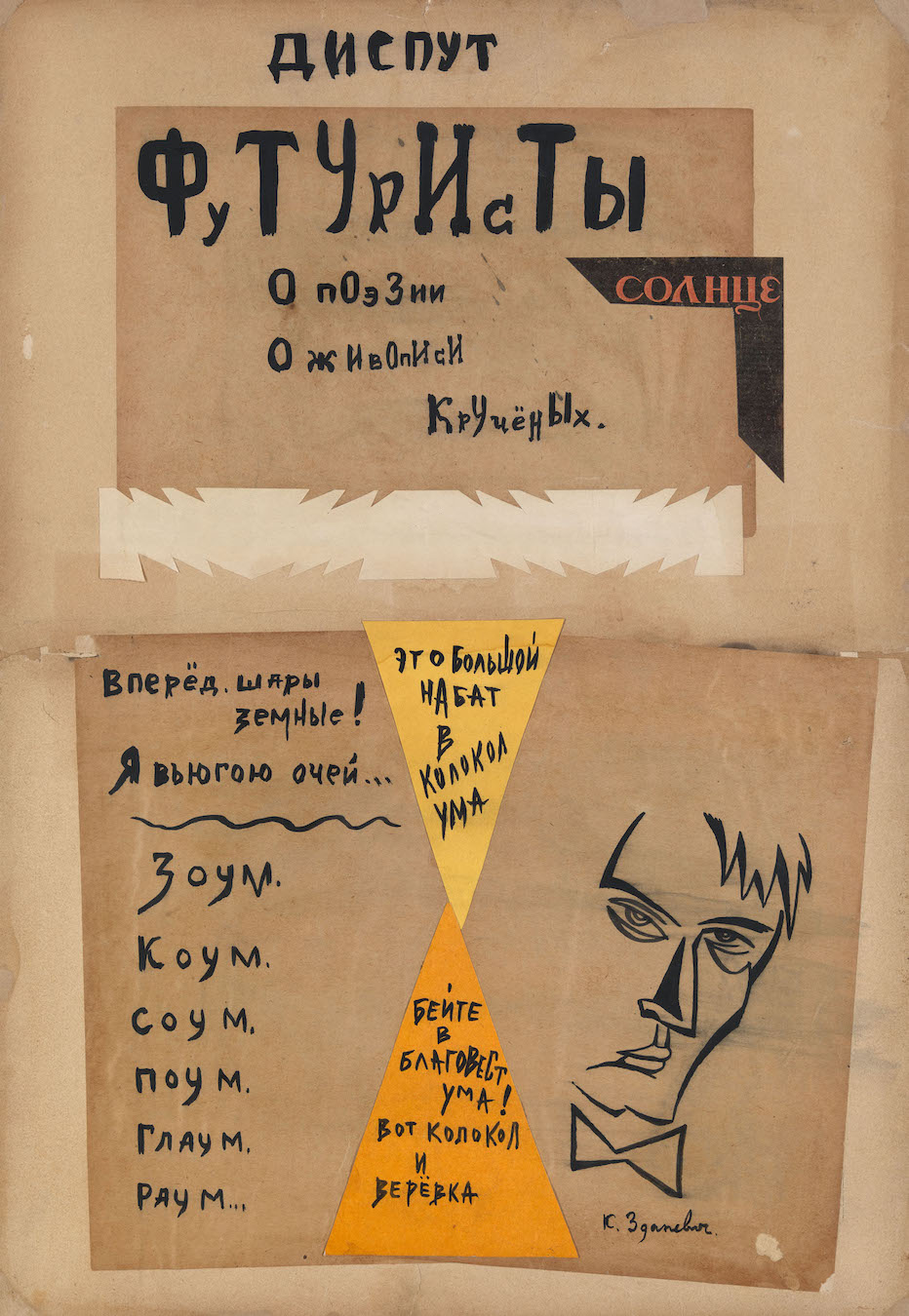2 December 2015 Russian Art Auctions
2 December 2015

* 61. ZDANEVICH, KIRILL (1892-1969)
Dispute. Futurists on Poetry, on Painting..., signed.
Ink and collage with paper on paper, laid on card, 52.5 by 36 cm.
25,000-40,000 GBP
Provenance: Acquired directly from the artist’s family by the present owners in Tbilisi, 1950s–1960s.
Important private collection, New York.
This unique collection consists of seven works on paper by the outstanding Futurist artist Krill Zdanevich, encompassing his most interesting and fruitful period, from 1914 to 1924.
By 1914, the year Zdanevich executed the earliest of these compositions, he had already quit the Imperial Academy of Arts to pursue his studies at the École des Beaux Arts in Paris, taken part in the legendary Donkey’s Tail (Oslinyi khvost) art group, co-authored the theoretical concept of “everythingness”, absorbed the ideas of Cubo-Futurism and immersed himself in the artistic melting pot of the avant-garde. Zdanevich worked alongside his brother Ilya on Futurist manifestos and illustrated the works of Alexei Kruchenykh, Vladimir Mayakovsky and other Futurist poets.
After a forced interruption of their artistic activity during World War I, the Zdanevich brothers moved to the capital of Georgia, Tiflis, which in the first post-revolutionary years emerged as a new centre of Futurist experimentation. The brothers renounced socio-political theorising and focused on consistent implementation of the most radical aesthetic concepts of Futurism. Kruchenykh, the so-called father of the Futurist movement, and the poet Igor Terentyev, who also happened to be in Tiflis at that time, became the masterminds of the city’s Futurist groupings.
In 1917, the progressive artists and poets of Tiflis formed the Syndicate of Futurists and then, a year later, reorganised themselves as the 41° group, which united the veterans of Russian Futurism: Kruchenykh, Terentyev and the Zdanevich brothers. The group, which took its name from the position of Tiflis at 41° northern latitude, became one of the most radical-leftist unions of the Russian and international avant-garde. Only the Dadaists, who implemented similar ideas, but on a different scale and across a wider space, bear comparison with the 41° group.
A manifesto published in the newspaper 41° (only one issue of which ever appeared) stated the main objective of the group to be the affirmation of abstruse (zaumnyi) language as “the compulsory form for the realisation of art”.
At this time, Kruchenykh developed the theory of economical poetry. Creating parallels in his hectographical books between extreme forms of literary zaum and the visual discoveries of objectlessness (bespredmetnost), he studied the sign as a universal and final image. Hence the focus, in publications by the 41° group, on the position of the sign on the page and the use of collage. Handmade works in this spirit can be found in Zdanevich’s art from this time.
In their manifesto, the 41° group issued a challenge “to put the world on
a new axis” and the “astro-geological” actions of their programme included a “battle with the Equator” and “battle of the Futurist (budetlyanin) with the Ocean”. This notion of victory through strife was also expressed in many works by Kirill Zdanevich.
In addition to their publishing activities, the 41° group members held evenings, meetings and discussions in a Tiflis art café, the Fantastic Tavern, which was a favoured venue for performances by various artists and artistic groups. Kirill Zdanevich often designed posters for such artistic debates and lectures, which were held not only in Tiflis, but also in Baku, Batumi and other cities of Transcaucasia. The sketches in various media that are included in the collection were created for this purpose.
The ideas of connections between planes and spaces, “cutting through” matter by the magnetic action of nature on the artistic consciousness were an inherent part of Russian Futurism. This metamorphosis inspired Kirill Zdanevich. His graphic compositions of the late 1910s present complex colour images with astonishing geometric plasticity. Their black outlines seem to make incisions in the paper, creating the illusion of spatial protrusions and indentations.
At the same time, Zdanevich created a series of geometric compositions for lithography – the visual equivalent of the poetic experiments of his brother Ilya, Alexei Kruchenykh and Vasily Kamensky. These works do not resemble drawings at all. Rather, they seem to reshape matter, driven by an ever more powerful avant-garde geometry.
The departure of Ilya Zdanevich in 1920, first to Constantinople and then to Paris, split the 41° group. Kirill Zdanevich, who remained in Tiflis, had to find a new use for his talents.
In the early 1920s, he rediscovered a field that he had known fleetingly during his pre-revolutionary years in Moscow, and in which he now fully immersed himself. Responding to the invitation of the director Konstantin Mardzhanov, Zdanevich worked as set designer for the avant-garde performances at Georgia’s Rustaveli Theatre of Drama.
In 1924 Mardzhanov, dissatisfied with the limited impact of theatre on
a mass audience, turned to cinema and called on Zdanevich to design his first cinematic project, a full-length film entitled The Petrels or Before the Storm (Burevestniki or Nakanune grozy). The film told a historical-revolutionary story and was funded by the People’s Commissariat for Social Welfare, with the proceeds to be used for famine relief. However, it was harshly criticised, and no copies have survived. The sketch by Zdanevich in this collection is one of the few remaining examples of the artist’s cinematic works of the 1920s.
Notes on symbols:
* Indicates 5% Import Duty Charge applies.
Ω Indicates 20% Import Duty Charge applies.
§ Indicates Artist's Resale Right applies.
† Indicates Standard VAT scheme applies, and the rate of 20% VAT will be charged on both hammer price and premium.